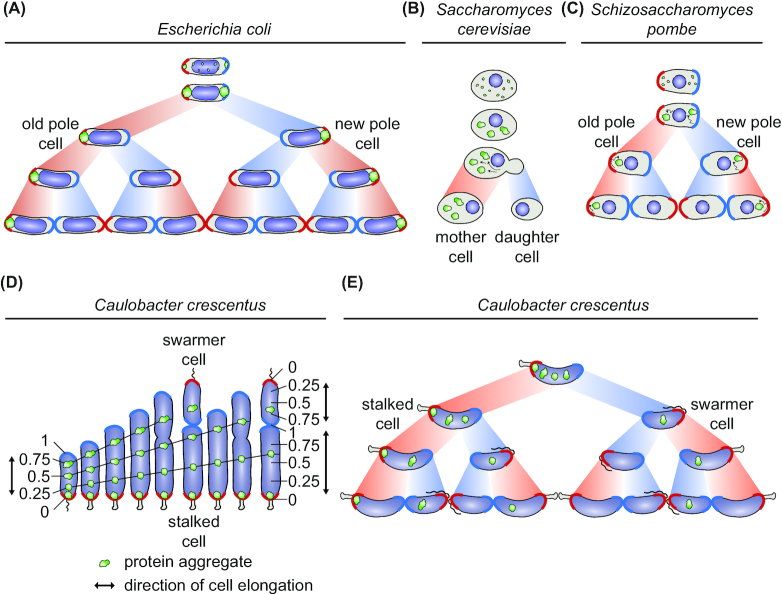Figure 5.
Aggregate formation and inheritance in unicellular organisms. (A), In E. coli, cells are born with an old pole (labeled in red) present in the progenitor cell and a new pole (labeled in blue) built during division. The cell inheriting the old pole of the progenitor cell is termed the old pole daughter cell and the one inheriting the new pole the new pole daughter cell. An E. coli population consists of cell lineages with many different pole inheritance histories (red areas connecting cells indicate old pole inheritance, blue areas new pole inheritance). In E. coli, aggregating proteins (green particles) are occluded from the central nucleoid (violet region), enforcing aggregate localization at the nucleoid-free poles from which they rarely move. This pattern creates a strong asymmetry of aggregate inheritance as aggregates are specifically retained in the cell lineages consecutively inheriting the progenitor cell's old pole. (B), During asymmetric cell division of S. cerevisiae a smaller cell buds off from a larger mother cell. Heat shock-induced aggregates are collected and deposited at different sites in the cell and are actively and passively retained in the mother cell, creating strong asymmetry of aggregate distribution. (C), In the symmetrically dividing S. pombe stress-induced aggregates form and fuse together either in the space between old pole and the nucleus (violet circle) or new pole and the nucleus. Aggregates are mobile however the nucleus impedes frequent movement to the opposite pole half. This leads to preferential aggregate retention in cell lineages consecutively inheriting the progenitor cell's old pole. (D), Schematic showing how growth along the length of the cell outside the pole regions determines aggregate localization and inheritance in C. crescentus. In this organism, cell division is asymmetric and yields a larger stalked cell (the old pole cell) and a smaller swarmer cell (the new pole cell). The C. crescentus nucleoid expands through the entire cell and aggregates form as distributed foci throughout the length of the cell. Numbers represent relative cell positions between the old (0) and new pole (1). Lines depict these relative positions as the cell elongates and divides. With each division event, aggregates will gradually assume a position closer to the new pole until they are inherited by the other cell type. A minority of aggregates remain trapped after forming at the pole. (E), C. crescentus aggregate inheritance pattern resulting from the process described in (D). Aggregates are not retained in the lineage consecutively inheriting the old pole, but instead are constantly distributed between old and new pole cells (with the exception of the minor pole aggregate fraction).

